Nvidia RTX 5070 vs RTX 4070 Super: Blackwell against Ada refresh in 2025
The latest and greatest?
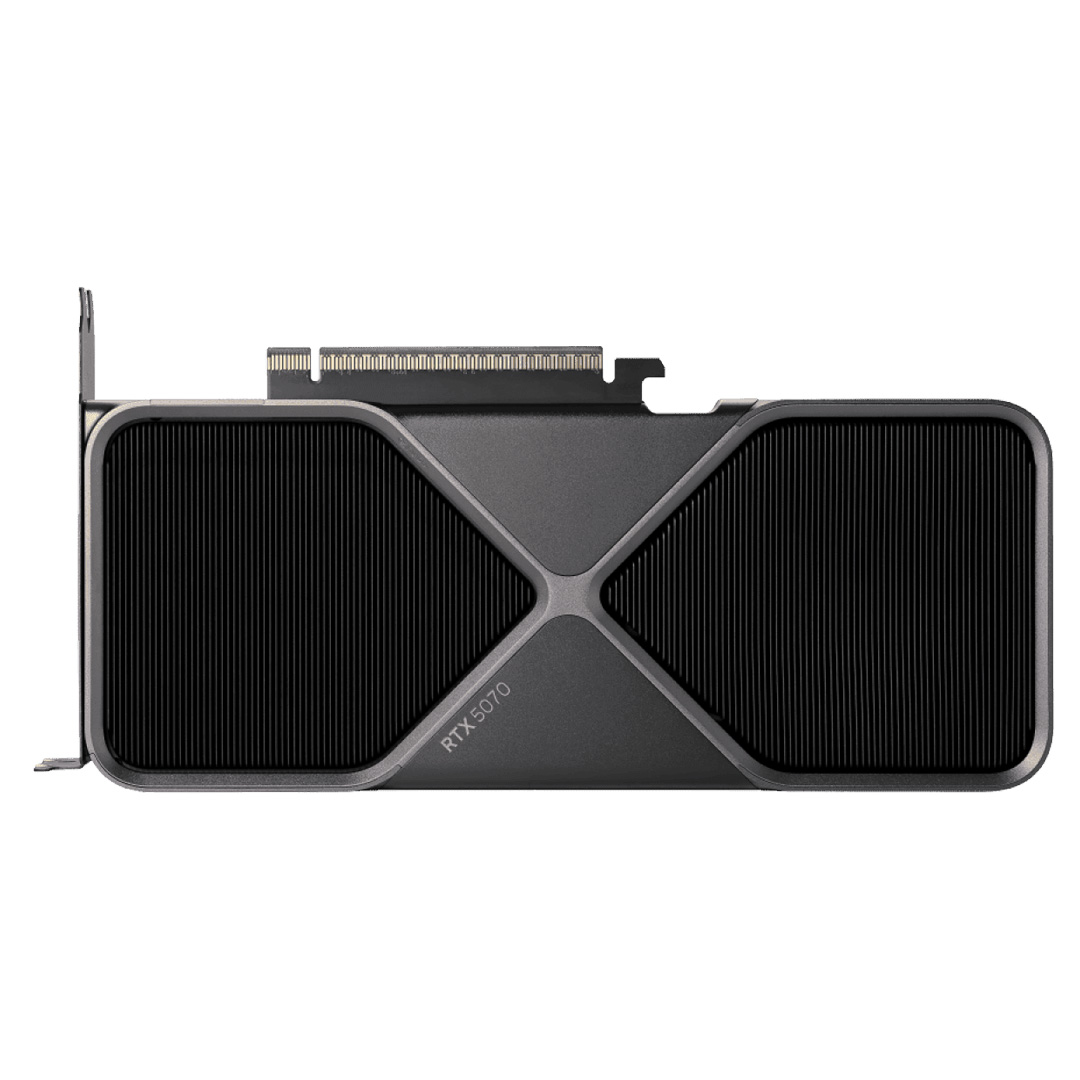
Compute Units: 48
Shaders: 6,144
Ray processors: 48
AI/Tensor processors: 192
Boost clock: 2,512 MHz
Memory type: GDDR7
Memory pool: 12 GB
Memory speed (effective): 28 Gbps
Memory bandwidth: 672 GB/s
Bus interface: 192-bit
TGP: 250W
Power connector: 1 x 16-pin
Slot width: Dual-slot
For
- Multi Frame Generation is impressive
- No increase in price over RTX 4070
- Excellent 1440p performance
- PCIe 5.0 and GDDR7
- Great midrange creative performance
Against
- Almost no improvement over RTX 4070 Super
- Multi Frame Generation isn't widely supported
- Only 12GB VRAM...AGAIN
- Higher power draw for no real gain
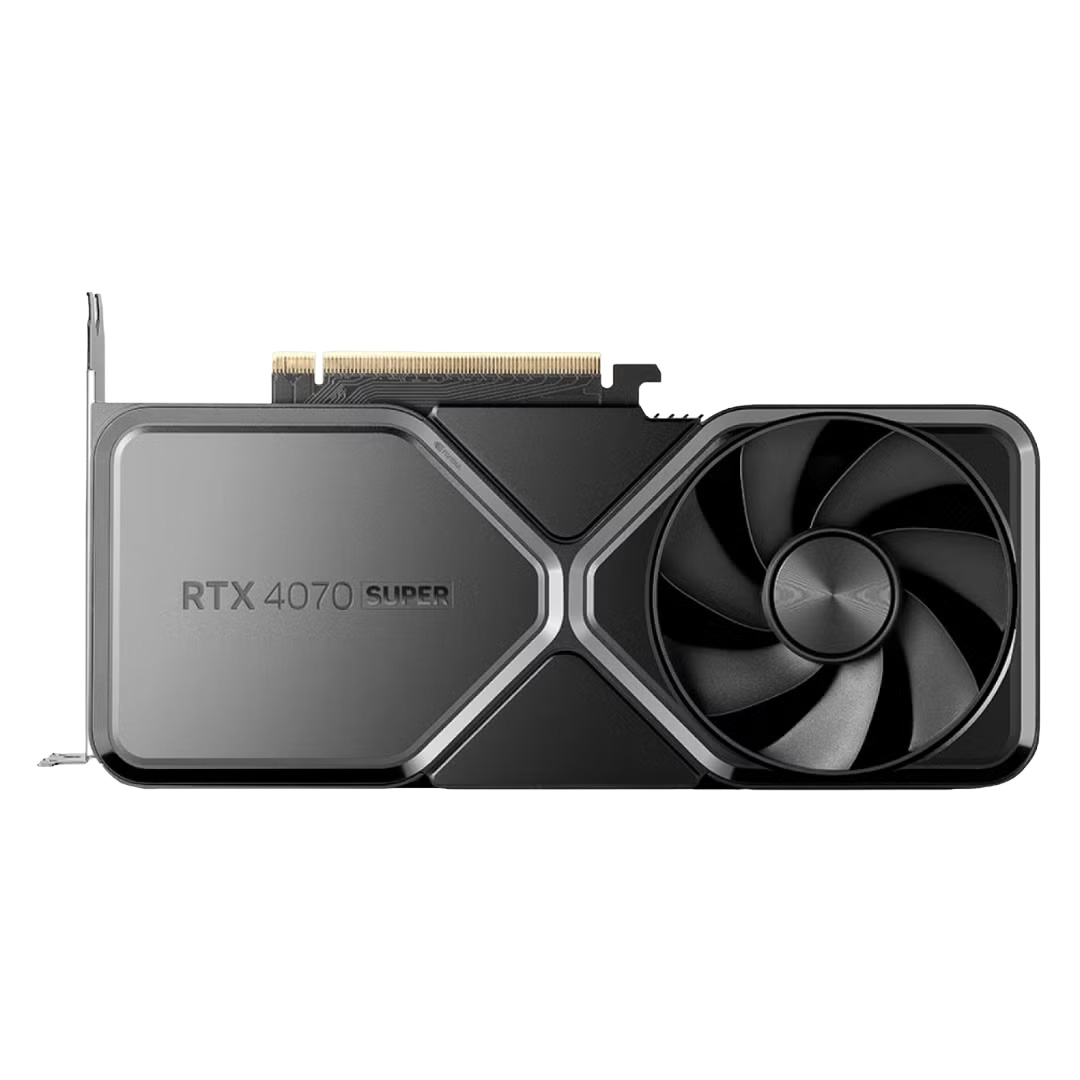
Compute Units: 56
Shaders: 7,168
Ray processors: 56
AI/Tensor processors: 224
Boost clock: 2,475 MHz
Memory type: GDDR6X
Memory pool: 12 GB
Memory speed (effective): 21 Gbps
Memory bandwidth: 504GB/s
Bus interface: 192-bit
TGP: 220W
Power connector: 1 x 16-pin
Slot width: Dual-slot
For
- Fantastic performance
- Same price as RTX 4070 launch MSRP
- Higher core count and base clock
- Gorgeous design
Against
- Gamers will be better off with RX 7800 XT
- Still just 12GB VRAM
- Higher power draw
- Still expensive for a midrange card
Few things move as quickly as components in the computing world, as it's been just over one year since the Ada refresh lineup arrived with the RTX 4070 Super in January 2024. Now, in April 2025, we're graced by a full-on follow-up in the form of the RTX 5070, which hit the shelves on March 5, 2025, aiming to be the midrange market leader for gamers and creatives.
Nvidia hasn't been shy about showing off with its new Blackwell GPU architecture, with particularly bold claims of stating how the RTX 5070 compares to the RTX 4090 (when using the brand-new Multi Frame Generation tech, of course). But how does the RTX 5070 fare against the RTX 4070 Super? That's what we're here to find out; we're comparing their price, specs, and performance so you can make a well-informed decision for your next build or upgrade in 2025.
We described the RTX 4070 Super as "the best midrange graphics card out there" just over a year ago. How well does this statement hold up when contrasted against the new blood? It's time to see if the latest addition to Nvidia's GPU lineage can match its predecessor and stand alongside it as one of the best graphics cards on the market (or not).
Nvidia RTX 5070 vs RTX 4070 Super: Price
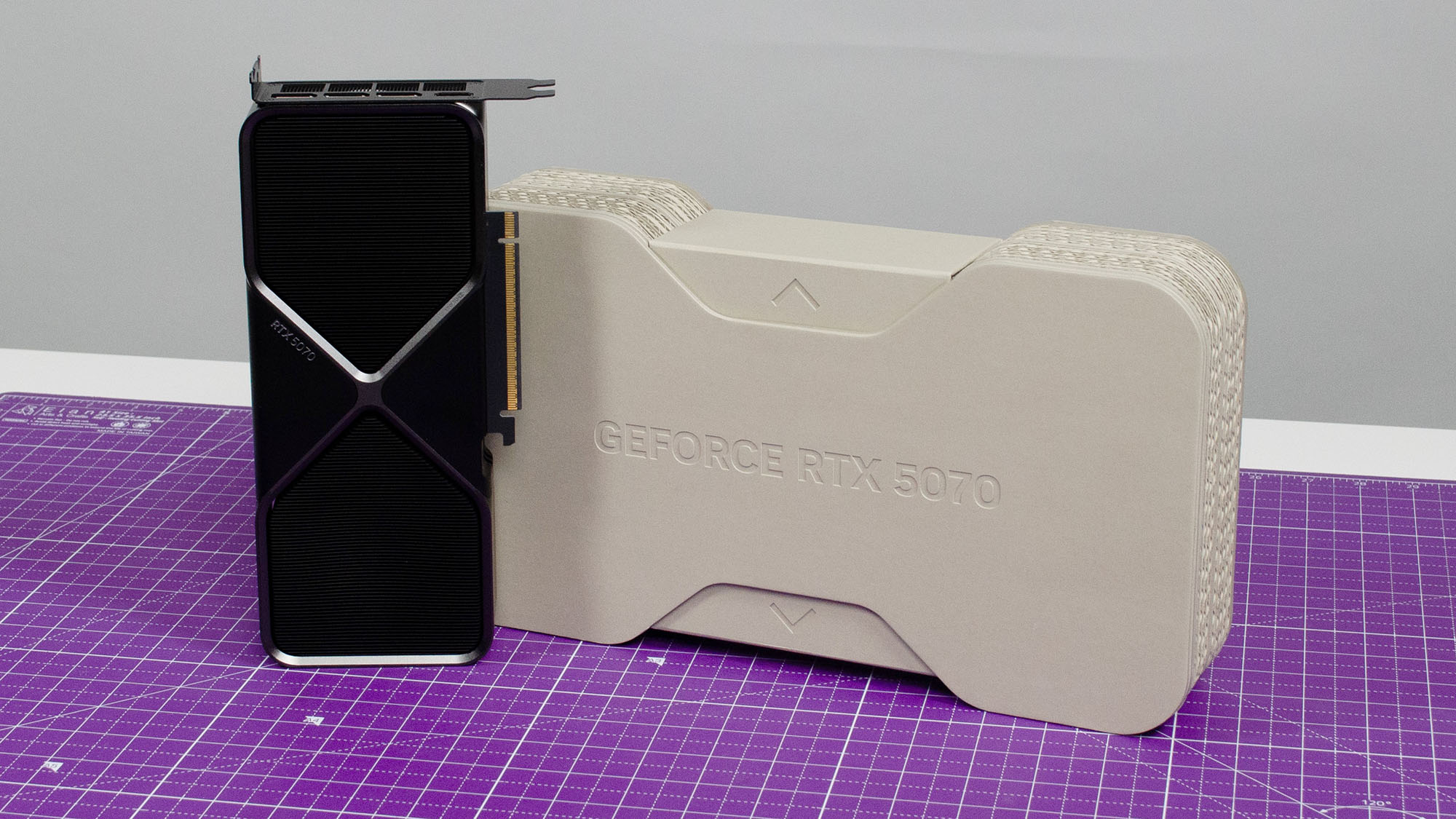
Up first is the comparison of the prices of the RTX 5070 vs RTX 4070 Super. Defying expectation, the hardware manufacturer has actually made its midrange offering cheaper by $50 at MSRP as the Blackwell mainstream offering debuted on March 5, 2025 and retails for $549. In contrast, Team Green's previous budget champion, the RTX 4070 Super, retailed for $599, itself matching the price point of the card it effectively replaced (the RTX 4070) from April 2023.
At a time where we've traditionally seen Nvidia raise prices with each respective GPU generation, it's a good pro-consumer move that the needle hasn't been raised with the RTX 5070 as we saw with Ada's launch compared to Ampere from 2022 and 2020, respectively. As such, the clear winner (at least on paper) is the RTX 5070 for being cheaper than what it's replacing.
However, it's no secret that Nvidia has been experiencing stock problems with the Blackwell line of graphics cards as the RTX 5090, RTX 5080, and RTX 5070 Ti remain scarce. It seems as though the RTX 5070 has succumbed to a similar fate, which makes the actual pricing recommendation a little murkier. In the situation that you can find the RTX 4070 Super cheaper (as stores begin to sell off the last remaining stock), then the opposite is true. With that said, at face value, the RTX 5070 takes the win in terms of recommended retail pricing.
- Winner: RTX 5070
Nvidia RTX 5070 vs RTX 4070: Specs
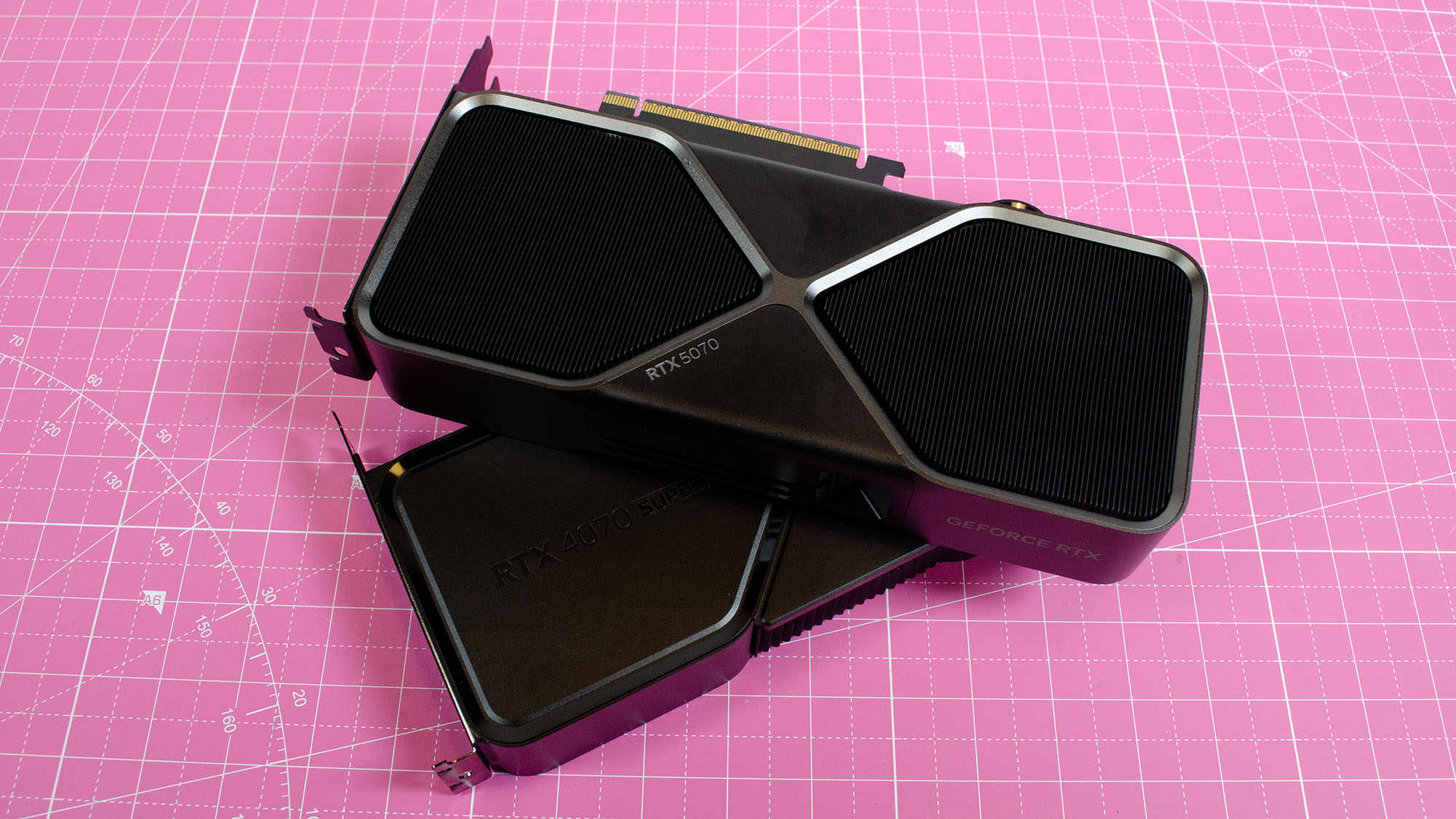
| Header Cell - Column 0 | Nvidia RTX 5070 | Nvidia RTX 4070 Super | % Difference |
|---|---|---|---|
Process Technology | TSMC N4P | TSMC N4 | N/A |
Transistors (Billion) | 31.1 | 35.8 | 15.11 |
Compute units | 48 | 56 | 16.6 |
Shaders | 6,144 | 7,168 | 16.6 |
AI/Matrix cores | 192 | 224 | 16.6 |
Ray Tracing Cores | 48 | 56 | 16.6 |
Render Output Units | 80 | 80 | 0 |
Texture Mapping Units | 192 | 224 | 16.6 |
Boost Clock (MHz) | 2,512 | 2,475 | 1.4 |
Memory type | GDDR7 | GDDR6X | N/A |
VRAM (GB) | 12 | 12 | 0 |
VRAM Bus Width | 192-bit | 192-bit | N/A |
VRAM Speed (Gbps) | 28 | 21 | 33.3 |
Bandwidth (GB/s) | 672 | 504 | 33.3 |
TDP (watts) | 250 | 220 | 13.6 |
PCIe Interface | PCIe 5.0 x16 | PCie 4.0 x16 | N/A |
What's immediately apparent when comparing the technical specifications of the RTX 5070 vs RTX 4070 Super is how the different architecture utilize VRAM. As with all Blackwell GPUs, the 5070 uses GDDR7 video memory as standard, which allows for substantially faster memory of 28 Gbps whereas the RTX 4070 Super is much slower at 21 Gbps.
It also means a larger bandwidth of faster memory, clocking in at 672GB/sec against the older Ada card's 504GB/sec. However, this comes at the cost of a slightly higher TDP of 250W up from the previous graphics card's 220W, a difference of 13.6%.
The utilization of faster memory is possible thanks to the PCIe 5.0 x16 port built on the card, which means around double the data transfer speeds when contrasted with PCIe 4.0.
Interestingly, the architectural shift from a TSMC N4P node from the TSMC N4 process has meant fewer Ray Tracing Cores, Shaders, Tensor Cores, and Texture Mapping Units (as well as fewer transistors overall) when compared to what's available on the older RTX 4070 Super.
Fundamentally, both 70-class graphics cards use 12GB VRAM on a 192-bit memory bus for gaming, creative workloads, and more. It all just comes down to how the different hardware is utilized, with the newer Blackwell GPU being geared more towards AI effiency (even being measured in total TOPS by Nvidia) against what Ada's core mission of efficency versus Ampere was when that generation launched in 2022.
- Winner: RTX 5070
RTX 5070 vs RTX 4070 Super: Performance
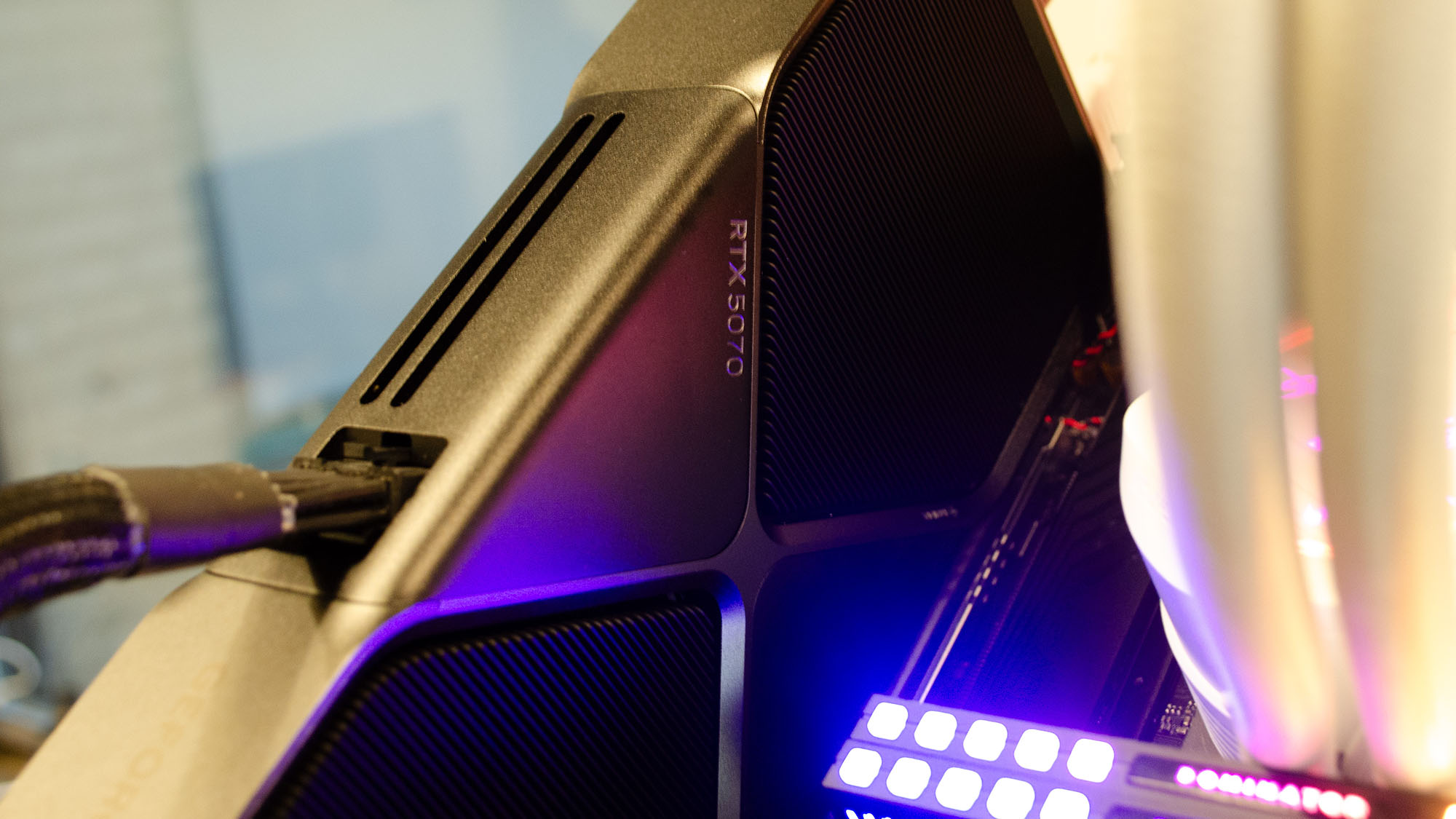
While analyzing each respective graphics card can give us a rough idea of what they can do for their class, it's only when judging based on the numbers can we really see what they're made of. That's the biggest thing that separates the RTX 5070 vs RTX 4070: performance.
Starting with the synthetic benchmarks, there's something of a division depending on the task as to which video card pulls ahead. Certain programs, like the GeekBench 6 Compute benchmark, see the older RTX 4070 Super pull ahead with superior figures of 204,197 against the RTX 5070's 188,847 score (a difference of 8.12%).
However, there are other instances where Blackwell confidently leads, such as can be seen with the V-Ray 6 CUDA benchmark with 6,455 against the RTX 4070 Super's 5,522 and with 3DMark across the board. It seems to be situational, where the older card edges things out.
If you're hoping for a dramatic generational leap in terms of 1440p gaming performance with the RTX 5070 vs RTX 4070 Super, then you may be disappointed. Take demanding games like Black Myth: Wukong, for instance, with average frame rates of 80 for the former and 69 for the latter (an 11-frame difference).
Things open more with Cyberpunk 2077 at Ultra settings, with the 5070 achieving 106fps against the RTX 4070 Super's 92fps (a 15.2% improvement), showcasing the added benefit of GDDR7 VRAM. Some games see little to no improvement, as can be observed by comparing the RTX 5070 vs RTX 4070 Super in Civilization VII's average framerate (204fps versus 202fps) and Dying Light 2 (150 versus 142) for an increase of 1% and 5%, respectively.
Things are close when bumping the resolution up from 1440p to 4K, with the RTX 5070 (largely) comparable with the older RTX 4070 Super.
There's a single frame of difference in Black Myth: Wukong in 2160p (54fps for the 5070 versus 53fps for the 4070 Super). However, the gap is widened with Cyberpunk 2077 and Dying Light 2, with the RTX 5070 reaching heights of 76fps and 132fps against the RTX 4070 Super's 64fps and 128fps with DLSS set to Balanced. The Blackwell GPU pulls ahead, albeit not by much.
Creative workloads are close as well, with the RTX 4070 Super outpacing the RTX 5070 Super in some tests, such as the Blender 4.30 Classroom benchmark (1,597 to 1,554). However, at other times, the two GPUs were either identical or near-identical, as can be evidenced by the benchmarks in CrossMark Creativity (2,805 and 2,804) and Handbrake 1.6 4K to 1080p H.264 encoding test (216fps apiece).
- Winner: RTX 5070
Nvidia RTX 5070 vs RTX 4070 Super: Verdict
If one thing's clear from our analysis of the RTX 5070 vs RTX 4070 Super by price, specs, and performance, it's that you shouldn't upgrade from the Ada refresh to the brand-new Blackwell; the slight 1-3% improvement (if that) jump is simply not going to be worth shelling out (likely) upwards of $600 unless you have your heart set on DLSS 4 exclusive features such as Multi Frame Generation (and game primarily in 1440p).
However, if you're thinking of upgrading to an RTX 5070 from an RTX 3070 (or older), then the choice between the two is far more palatable. Of course, a key deciding factor in choosing between one and the other is going to be availability, something that Ada doesn't suffer with the way that Blackwell does. It doesn't seem like the jump to GDDR7 memory has really benefitted Nvidia's midrange lineup the way that some were hopeful it would, at least when directly compared to the previous market option.
If you can find an RTX 5070 for MSRP then it's worthwhile over the RTX 4070 Super. However, don't spend over the odds in upgrading if the older Ada card is more readily available to you.
- Winner: RTX 5070
Get daily insight, inspiration and deals in your inbox
Sign up for breaking news, reviews, opinion, top tech deals, and more.

Formerly TechRadar Gaming's Hardware Editor, Aleksha McLoughlin is now a freelance writer and editor specializing in computing tech, video games, and E-commerce. As well as her many contributions to this site, you'll also find her work available on sister sites such as PC Gamer, GamesRadar, and Android Central. Additionally, more of her bylines can be found on Trusted Reviews, Dexerto, Expert Reviews, Techopedia, PC Guide, VideoGamer, and more.
You must confirm your public display name before commenting
Please logout and then login again, you will then be prompted to enter your display name.